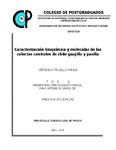| dc.description.abstract | La diversidad de chiles en México es amplia y su uso tiene gran importancia en la gastronomía. Los chiles tipo guajillo, pasilla y puya figuran entre los más utilizados para la preparación de platillos regionales. Una de las formas para conocer y cuantificar su diversidad es mediante la caracterización, ya sea a nivel bioquímico, molecular o morfológico. En particular, la caracterización a nivel bioquímico permite identificar y cuantificar metabolitos secundarios de interés, en tanto que a nivel molecular se puede obtener información de la estructura genética de las poblaciones y parámetros de diversidad, entre otros. Sin embargo, la mayoría de estos estudios se ha enfocado en muestras que no siempre representan claramente la variación dentro de un tipo de chile, por lo que es necesario realizar estudios con un número mayor de accesiones representativas, utilizando colectas centrales, para generar una base amplia de conocimiento. Por lo anterior, el objetivo de este estudio fue realizar una caracterización bioquímica y molecular de dos colectas centrales, una de chile guajillo (15 poblaciones) y otra de chile pasilla (11 poblaciones), además de cinco accesiones de chile puya. La caracterización bioquímica se hizo mediante espectrofotometría y cromatografía de líquidos de alta resolución y la molecular se realizó con 15 loci de microsatélites. En cuanto a la caracterización bioquímica, el chile puya mostró el mayor contenido de capsaicinoides, y el chile pasilla presentó el mayor contenido de carotenoides y de flavonoides. Se observó una amplia variabilidad en el contenido de los metabolitos secundarios cuantificados. También se encontró un comportamiento diferencial en los dos ambientes. En relación al color, el chile pasilla presentó un color rojo obscuro, y el chile guajillo y puya un rojo claro brillante. Por otro lado, en la caracterización molecular de las poblaciones de chile se detectaron 137 alelos, 7.67 alelos por locus para el chile guajillo, 6.47 alelos para pasilla y 5.27 para puya, y un polimorfismo general de 88.9%. Se encontró un exceso de heterocigotos en sus poblaciones. Los estadísticos de F indicaron que la variación es mayor dentro de tipos de chile que entre tipos de chile. En el análisis de componentes principales se formaron cuatro grupos, coincidiendo con el análisis de conglomerados para las mismas poblaciones, lo que indica que las poblaciones dentro de un mismo grupo comparten los mismos alelos. La similitud esperada entre chile guajillo y chile puya no fue visible, ya que el chile guajillo comparte alelos con algunas poblaciones de chile pasilla y éste último comparte alelos también con chile puya, sin existir relación genética con este análisis entre guajillo y puya. La diversidad bioquímica y molecular que se encontró en este estudio permite identificar la variabilidad entre y dentro de los chiles guajillo, pasilla y puya, misma que podría ser utilizada en programas de conservación y mejoramiento genético. _______________ BIOCHEMICAL AND MOLECULAR CHARACTERIZATION OF CORE COLLECTIONS OF CHILE GUAJILLO AND PASILLA. ABSTRACT: The diversity of chiles in Mexico is large and their use is of great importance in gastronomy. Chiles guajillo, pasilla and puya are among the most used in the preparation of regional dishes. One way of identifying and quantifying Capsicum diversity is by characterizing it, at biochemical, morphological or molecular level. Particularly, a biochemical characterization allows to identify and quantify secondary metabolites of interest, while a molecular characterization gives information about the genetic structure of populations, genetic diversity parameters, among other pieces of information. However, most of these studies have focused on a small number of accessions that do not clearly show the variation within a type of chile. Thus, it is necessary to carry out studies using a larger number of representative populations, using core collections, to generate a broad base of knowledge. Therefore, the aim of this study was to biochemically and molecularly characterize a core collection of chile guajillo (15 accessions), another of pasilla (11 accessions), and five additional accessions of chile puya. Biochemical characterization was performed using spectrophotometry and high pressure liquid chromatography, and molecular characterization was carried out with 15 microsatellite loci. As for the biochemical characterization, chile puya had the highest capsaicinoids content, and the pasilla type had the highest content of carotenoids and flavonoids. It was found that the core collections had a wide variability in the content of secondary metabolites. A differential behavior was also found in the two environments evaluated. Regarding to the color, pasilla type had a dark red color, and chiles guajillo and puya a bright light red. On the other hand, in the molecular characterization of chile accessions, 137 alleles were detected, 7.67 alleles per locus for chile guajillo, 6.47 alleles for chile pasilla, and 5.27 alleles for chile puya, and an overall polymorphism of 88.9%. An excess of heterozygotes was found in chile accessions. The F statistics showed that the variation is greater within chile accessions from the same type that it is among types of chile. The principal component analysis resulted in four groups, coinciding with the dendrogram for the same accessions, which indicates that accessions within the same group share the same alleles. The expected similarity between chile guajillo and chile puya was not visible, since chile guajillo shares alleles with some pasilla accessions and the latter also shares alleles with chile puya, without showing a clear genetic relation between chiles guajillo and puya in this study. Biochemical and molecular diversity found in this study allows to identify the variability among types of chile and within chiles guajillo, pasilla, and puya, and this germplasm variability could be used in conservation and breeding programs. | es_MX |


